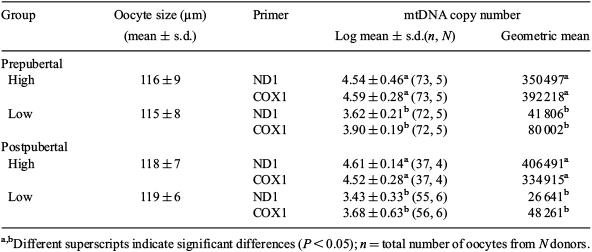181 mtDNA COPY NUMBER IN OOCYTES OF DIFFERENT SIZES FROM INDIVIDUAL PRE- AND POST-PUBERTAL PIGS
H. S. Pedersen A , P. Løvendahl A , K. Larsen A , L. B. Madsen A and H. Callesen AAarhus University, Tjele, Denmark
Reproduction, Fertility and Development 27(1) 181-182 https://doi.org/10.1071/RDv27n1Ab181
Published: 4 December 2014
Abstract
Oocyte competence has been related to mtDNA copy number, but a large variation in mtDNA copy number between oocytes has been observed, caused by, e.g. oocyte donor and oocyte size (Sato et al. 2014 PLOS ONE 9, e94488; Cotterill et al. 2013 Mol. Hum. Reprod. 19, 444–450; El Shourbagy et al. 2006 Reproduction 131, 233–245). However, the correlation between size and mtDNA copy number in single oocytes has not been determined. This study describes the relation between oocytes of defined diameters from individual pre- and postpubertal pigs and mtDNA copy number. Cumulus-oocyte complexes were aspirated from ovaries of 10 pre- and 10 post-pubertal pigs. Cumulus cells were removed and the oocytes were measured (inside-ZP-diameter). Oocytes were transferred to DNAase-free tubes, snap-frozen, and stored at –80°C. The genes ND1 and COX1 were used to determine the mtDNA copy number. Plasmid preparations containing ND1 and COX1 were used to prepare standard curves. Q-PCR reactions using ND1and COX1 specific primers and probes were run in triplicate on a ViiA7 real-time PCR system using TaqMan (Applied BioSystems, Foster City, CA, USA). Standard curves showed high correlation coefficients (r2 = 0.99–1.00) and amplification efficiencies (COX1, 91–104%; ND1, 84–92%). As inter-assay control, standard curves were compared using interaction with dates, showing no differences. mtDNA copy number between groups was compared by ANOVA after log-transformation of data. Relationship between oocyte size and mtDNA copy number was analysed using linear regression. Data were analysed by SAS procedures, SGPLOT and GLM (SAS 9.3, SAS Institute Inc., Cary, NC, USA) with P < 0.05 as significance level. In total, 145 pre- and 93 post-pubertal oocytes were analysed (6–15 from each donor). Mean mtDNA copy number in oocytes from any individual donor was either high (≥100 000) or low (<100 000) with no differences between pre- and post-pubertal oocytes. No differences were detected in mtDNA copy number using either of the two primers (Table 1). No linear correlation was detected between oocyte size and mtDNA copy number in pre- and postpubertal oocytes (r2 = 0.00). The donor has a strong influence on oocyte mtDNA copy number in pre- and postpubertal pigs, which could influence individual fertility. mtDNA copy number does not seem to explain the higher developmental competence of neither post- compared to prepubertal pigs nor large compared to small prepubertal oocytes. The impact of individual on mtDNA copy number should be considered for experimental designs and future investigations.

|


